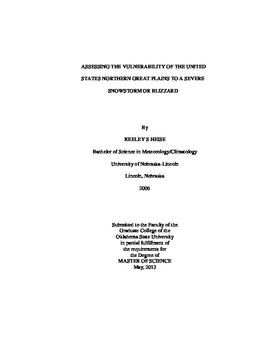| dc.contributor.advisor | Stadler, Stephen J. | |
| dc.contributor.author | Heise, Keeley | |
| dc.date.accessioned | 2014-09-24T14:18:02Z | |
| dc.date.available | 2014-09-24T14:18:02Z | |
| dc.date.issued | 2013-05-01 | |
| dc.identifier.uri | https://hdl.handle.net/11244/11090 | |
| dc.description.abstract | With projected increases in the occurrence of weather extremes in a changing climate, especially in the central United States, the chances of severe snowstorms or blizzards like those of the past happening again are increasing. The northern Great Plains region of the United States is the focus of this study. Using data from the National Oceanic and Atmospheric Administration daily weather map series for 1950-1980, weather data was collected for the twenty-six stations located within the study area for the months of October through April. In order to be chosen for inclusion in the study, the station had to have wind speeds of at least 20 knots, visibility 3 miles or less and snow falling at the time of observation. This data was used to calculate the number of days under blizzard, near blizzard, and snowstorm conditions for each location to determine which areas were at the highest risk for experiencing a severe snowstorm or blizzard. The vulnerability analysis was conducted by downloading county level data from the 2010 US Census. Fourteen variables shown to have an impact on vulnerability were chosen and combined using an additive index created by Susan Cutter called the Social Vulnerability Index. This was done both with and without the poverty variable, which has been shown to be highly correlated with vulnerability, to see if there was a difference in the results. The resulting images appeared to be mirror images of each other with areas showing above average vulnerability with poverty included showing below average vulnerability without it. These results were compared to the storm classification categories to see if the high risk areas coincided with the highly vulnerable areas. With poverty included in the calculations, this was seen to be the case. The vulnerability scores were tested using Moran's I for significance to the pattern which showed there to be significant clustering of like values throughout the area. | |
| dc.format | application/pdf | |
| dc.language | en_US | |
| dc.publisher | Oklahoma State University | |
| dc.rights | Copyright is held by the author who has granted the Oklahoma State University Library the non-exclusive right to share this material in its institutional repository. Contact Digital Library Services at lib-dls@okstate.edu or 405-744-9161 for the permission policy on the use, reproduction or distribution of this material. | |
| dc.title | Assessing the Vulnerability of the United States Northern Great Plains to a Severe Snowstorm Or Blizzard | |
| dc.type | text | |
| dc.contributor.committeeMember | Wikle, Thomas A. | |
| dc.contributor.committeeMember | Bays, Brad Alan | |
| osu.filename | Heise_okstate_0664M_12693.pdf | |
| osu.accesstype | Open Access | |
| dc.description.department | Geography | |
| dc.type.genre | Thesis | |
| dc.subject.keywords | blizzards | |
| dc.subject.keywords | hazards | |
| dc.subject.keywords | social vulnerability index | |
| dc.subject.keywords | vulnerability | |
